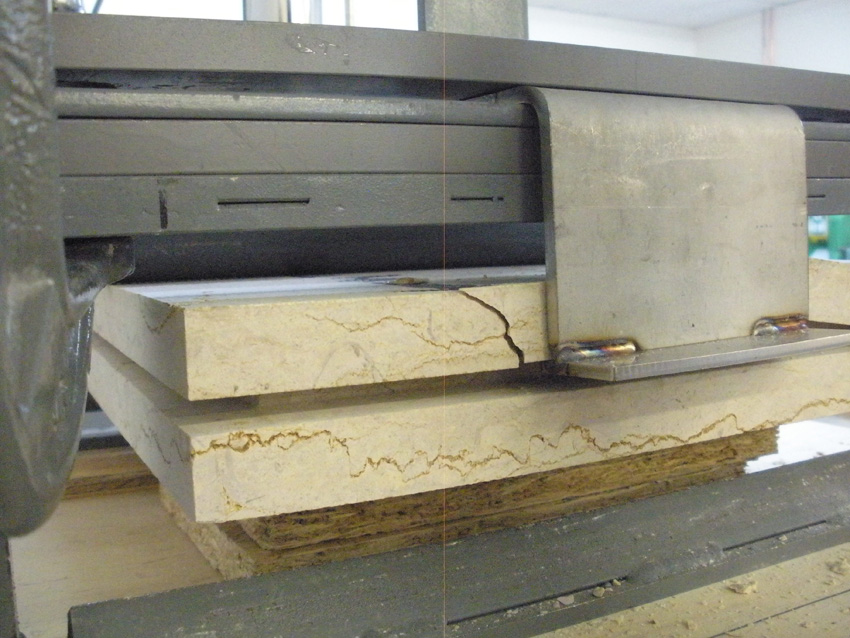The Importance of Testing When Specifying Natural Stone
 1 AIA LU/HSW; 0.1 IACET CEU*; 1 AIBD P-CE; AAA 1 Structured Learning Hour; This course can be self-reported to the AANB, as per their CE Guidelines; AAPEI 1 Structured Learning Hour; This course can be self-reported to the AIBC, as per their CE Guidelines.; MAA 1 Structured Learning Hour; This course can be self-reported to the NLAA.; This course can be self-reported to the NSAA; NWTAA 1 Structured Learning Hour; OAA 1 Learning Hour; SAA 1 Hour of Core Learning
1 AIA LU/HSW; 0.1 IACET CEU*; 1 AIBD P-CE; AAA 1 Structured Learning Hour; This course can be self-reported to the AANB, as per their CE Guidelines; AAPEI 1 Structured Learning Hour; This course can be self-reported to the AIBC, as per their CE Guidelines.; MAA 1 Structured Learning Hour; This course can be self-reported to the NLAA.; This course can be self-reported to the NSAA; NWTAA 1 Structured Learning Hour; OAA 1 Learning Hour; SAA 1 Hour of Core Learning
Learning Objectives:
- Explain why and how ASTM test standards help ensure safety and quality of a natural stone application.
- Describe which ASTM and/or ANSI tests are applicable to interior, exterior, and walking surface applications.
- Discuss how to interpret test results and their implications for material selection.
- Create a plan using relevant test data to select the proper stone for specific applications to ensure a safe occupied space.
This course is part of the Natural Stone Academy
Testing for Interior and Walking Surface Applications
Because stone installed inside of buildings is protected from many of the forces and elements to which exterior stone is exposed, design professionals have much greater freedom when specifying stone for interior applications. In general terms, the biggest consideration is whether the stone will be used in a vertical or horizontal application. Horizontal applications include flooring, countertops, or lavatory tops. Vertical applications include walls, backsplashes, mantels, and tub surrounds.
If the stone is going to be used as a decorative element, the choices are virtually unlimited. At the very least, the specifier still should obtain basic test data, including absorption and density, for these stones. Stone used as flooring or countertops have special considerations, as do stones that are frequently exposed to water or other liquids.
Test Methods for (Horizontal) Flooring Applications
There are two major considerations specific to stone used for flooring: its wear or abrasion resistance and its slip resistance. These are measured using two separate and distinct tests.

Long prized for its beauty and ease of maintenance, marble can help create graceful and timeless interiors and is often used in horizontal (flooring) applications.
Abrasion Resistance
Abrasion or wear resistance is crucial for stone products that are to be used in flooring applications. There are two tests used to test the abrasion resistance of stone that is to be used as a walking surface. ASTM C241: Standard Test Method for Abrasion Resistance of Stone Subjected to Foot Traffic was developed in the 1950s; however, this test had several limitations, one being that only one commercial testing laboratory owned the special machine required for the test. ASTM C241 is not widely used today. Instead, it has been largely replaced by ASTM C1353: Standard Test Method for Abrasion Resistance of Dimension Stone Subjected to Foot Traffic Using a Rotary Platform, Double-Head Abraser. Both of these test are used to evaluate a stone product’s abrasion resistance, as measured by an indexed value called Abrasive Hardness, or Ha. The higher the number, the more resistant the stone.
During the ASTM C1353 test, specimens are abraded using a Taber Abraser, a specialized machine with a rotating turntable and two rotating heads. Three specimens are tested, each measuring 4 inches square and less than ½ inch thick. One face should be flatsawn or ground and smoothed with 120 mesh grit. Rough surfaces, such as thermal, bush-hammered, gang-sawn, and cleft finishes, are not suitable. The stones are dried for 48 hours and weighed, abraded in the machine for 1,000 revolutions, dusted off, and weighed again. The function of the actual test is to measure how much mass was abraded from the stone. The resultant index value is proportional to this mass. It is important to note that ASTM C241 should be used for very hard stone because the testing methods for ASTM C1353 is not capable of abrading them.
The ASTM Materials Specifications include a minimum Ha value for each type of stone. You can refer to the DSDM for recommendations of minimum Ha by application.
In addition, the stone industry has established general thresholds for abrasive hardness for light, medium, and heavy traffic: •
- Light traffic: residential applications; minimum Ha of 6
- Moderate traffic: residential entries and small commercial installations; minimum Ha of 7
- Heavy traffic: commercial installations with 50-plus people per minute; minimum Ha of 10
- High-volume areas: lobbies, thresholds, and stairwells; minimum Ha of 12
- Exterior pavers: minimum Ha of 12
Slip Resistance
When specifying natural stone as flooring, it is important that it provides adequate traction, even when it is wet or greasy. Be aware that a floor’s finish can impact both its slip resistance and its tendency to attract dirt or stains. A more heavily textured floor may provide more “grip,” but it also has more topography that can catch particles.
In the past, the industry used a value called the static coefficient of friction (SCOF) to evaluate a material surface’s frictional resistance, or “slipperiness.” A test called ASTM C1028 was used to determine SCOF, which is defined as the amount of force required to displace a weighted plate that is set on a wet or dry surface. The higher the number, the more friction (i.e., less slippery)the surface. However, this test had some shortcomings. Because the application of the load was not automated, the test operator had considerable influence over the load application rate, directional bias, and uniformity. Also, the wet condition test sometimes created a suction that prevented it from providing reliable data on smooth and polished surfaces in wet conditions.
To address the shortcomings of the C1028 test, an ANSI accredited standards committee developed a new standard for measuring the slip resistance of floor tile. ANSI 326.3: Standard Test Method for Measuring Dynamic Coefficient of Friction of Hard Surface Flooring Materials describes a method for measuring the dynamic coefficient of friction, or DCOF. This is defined as the amount of force required to keep an object in motion as it slides over a tile. A 0.05 percent sodium lauryl sulfate solution is used to create a thin film on the stone surface, simulating a wet floor with a very low level of residual detergent.
The standard states that hard flooring suitable for level interior spaces expected to be walked on when wet from water shall have a “wet DCOF” of 0.42 or greater when tested.
It is important to understand that the 0.42 value represents a minimum level of slip resistance for level interior floors that are wet because of water. When this same flooring is contaminated with another “slipperier” substance—oil or grease, for instance—this level of friction may not be adequate.
It is also important to understand that 0.42 is not a magic number. Flooring with values below 0.42 may be safe for certain situations, and flooring with a DCOF greater than 0.42 may be unsafe in others. When evaluating safety, you will need to consider other factors, such as use and traffic, likelihood of spills, nature of substances that are likely to come into contact with the flooring, surrounding environment, and the slope of the floor.
Countertops
Though it is by no means the only choice, granite is an extremely popular countertop material, in part because it is hard, stable, and with a low porosity, as well as beautiful.
The design professional must weigh several factors when specifying stone for countertop applications. Will it hold up to abuse from stainless steel knives? Will it stain? Does it react to acids? Will the material harbor bacteria?
First, let’s consider hardness. While you can seek data for the Abrasive Hardness test, you can quickly evaluate a material using the Mohs Hardness Scale. This scale rates the relative hardness of a material between one and ten, with one being the softest and ten being the hardest.
In most cases, a less porous material will be more resistant to staining and bacterial growth, so test data for absorption and specific gravity is key when selecting countertop material. However, when it comes to chemical or acid resistance, this is closely related to the stone’s mineral makeup, so be sure to research the material for chemical reactivity.
Wet Areas
Showers, spas, and areas around urinals deserve special consideration. Not only are these areas subjected to continual streams of water, but some also must be able to withstand steam. Wet areas can be a breeding ground for mold and mildew. The Dimension Stone Design Manual provides guidance for best installation practices that dissuade mold and mildew growth, proper backerboard, ventilation fans, and the use of hard grout that is the full depth of the stone.
Some specifiers look to the absorption test, C97, to evaluate how a material will perform with regard to mold and mildew. However, installation materials and methods used to play a much larger role in potential damage. That does not mean you should not refer to C97 when specifying stone for wet areas. You should make sure that the material falls below the maximum value for absorption, as determined by testing and outlined in the Materials Specifications. You also can use C97 test data to compare one stone to another.
The soundness of the stone (the absence of flaws) and the construction of the stone (the elements that constitute the stone) are important factors in how the stone will perform in wet areas. Elements of iron and other minerals in stone can be unstable when exposed to moisture, leading to surface staining and stone degradation. The action of water on polished marble or limestone can cause surface dulling, spalling, warpage, or deterioration over time.
Here are the stones commonly used in showers and the allowable absorption values by weight:
- Marble: 0.20 percent maximum
- Limestone (Group 3 only): 3 percent maximum
- Granite: 0.40 percent maximum
- Quartz-based stone (quartzite): 1 percent maximum
- Slate 2: 0.25 percent maximum
Developing a Plan
You are beginning to see how you can start to create a plan for each general interior application that will ensure you use a thoroughly vetted material. For example, understand that the specification for a flooring application will require different and more extensive test data than for a decorative interior wall. In either case, you will want basic data such as absorption, density, and hardness for all of the stones you are considering. Still, your plan for flooring applications should include using data from the abrasive hardness requirements to winnow down your choices and DCOF test results to compare those that remain. Finally, do not forget to consult with the quarry or fabricator, as they have deep knowledge and valuable anecdotal information that can help inform your choices.
Conclusion
Natural stone is a durable, beautiful, and timeless material with a stunning variety of choices and applications. The design professional has a key role to play in making sure that the right stone is used in the right place. ASTM test data can guide the specifier’s choices, but it is critically important that he/she understand which tests are relevant to which application, and how to interpret the test data and use it in tandem with the Materials Specifications and knowledgeable advice from the supplier. By developing plans for each general type of application, the design professional can ensure that he/she is creating a thorough specification that will ultimately result in a successful installation—and a happy client.
 |
The Natural Stone Institute offers a wide array of technical and training resources, professional development, regulatory advocacy, and networking events for the natural stone industry. Learn more at www.naturalstoneinstitute.org/stoneacademy. |





 DCOF: A portable machine called the BOT3000 is used to test walking surfaces in the field. A lubricant is used to simulate a floor that is wetted with a residual detergent level.
DCOF: A portable machine called the BOT3000 is used to test walking surfaces in the field. A lubricant is used to simulate a floor that is wetted with a residual detergent level. 




